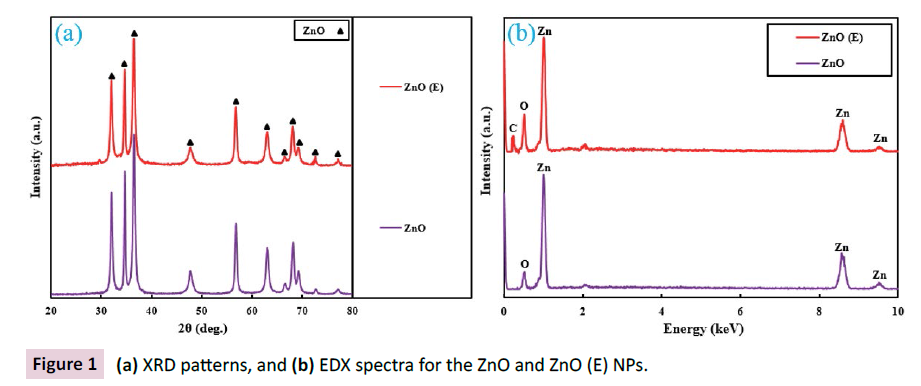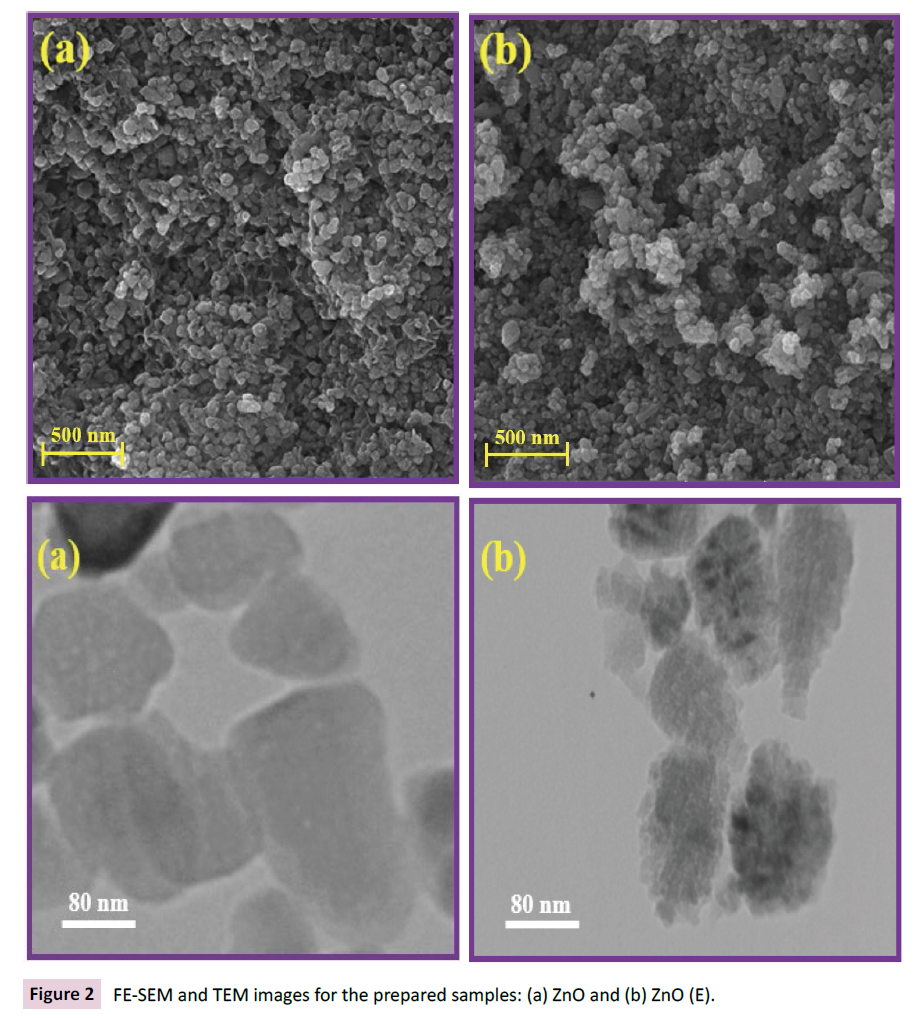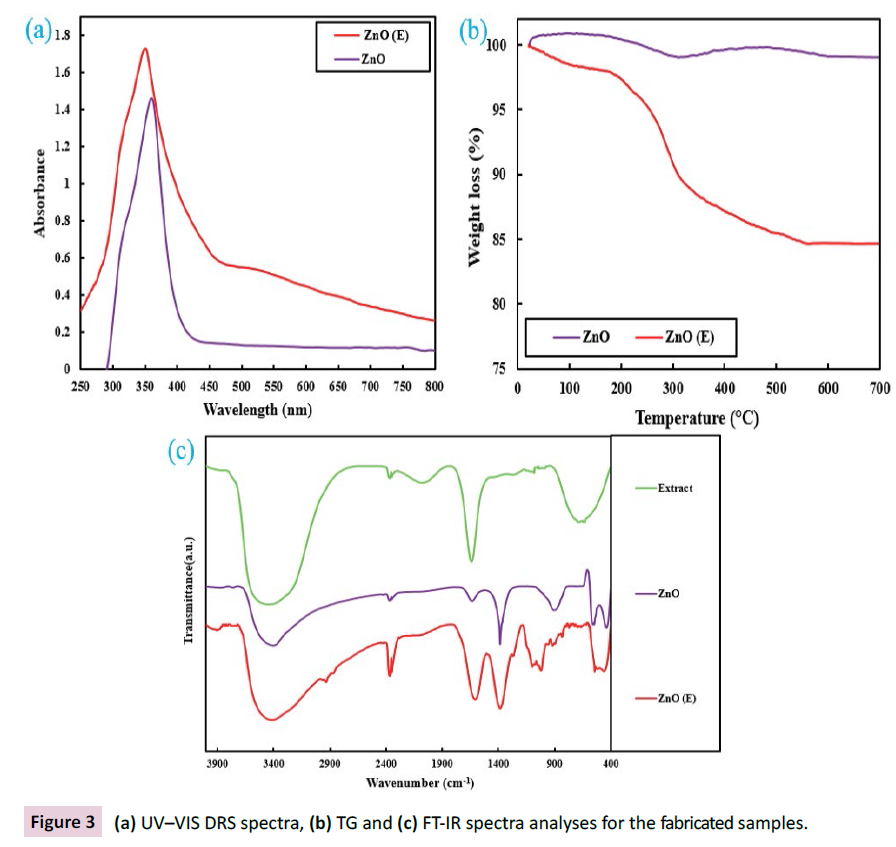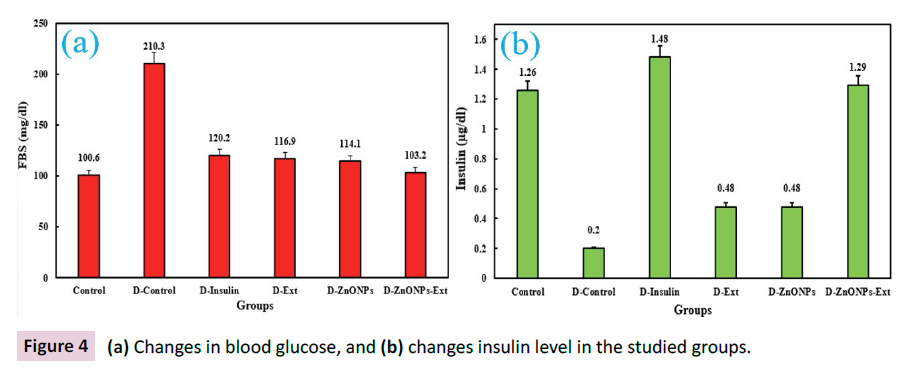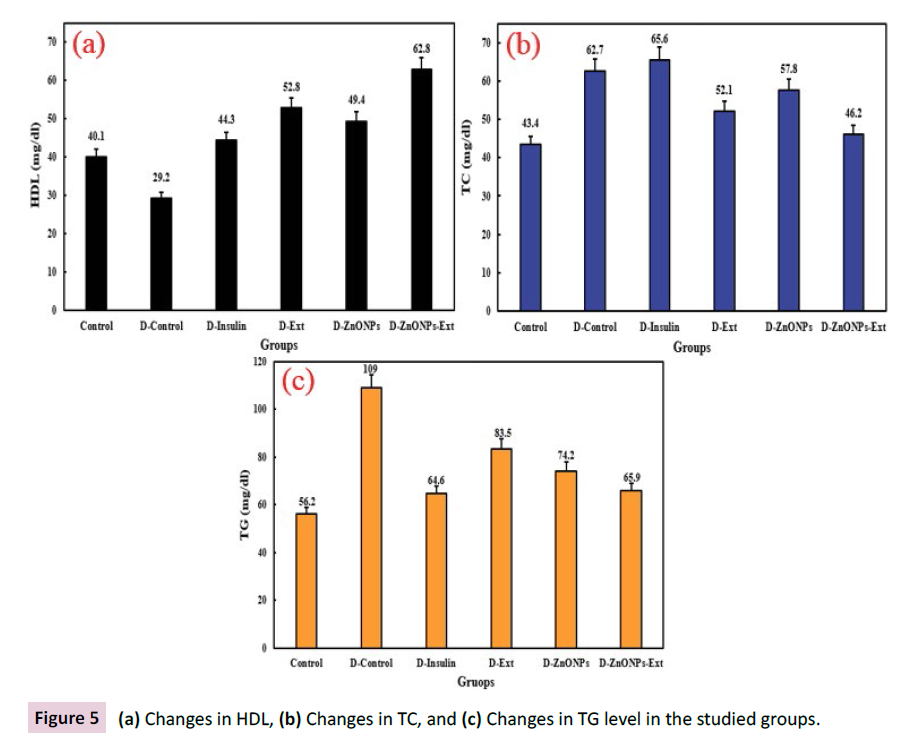Keywords
Green synthesis; ZnONPs; Diabetes; Insulin; Lipid profile
Introduction
Zinc is a crucial trace element for animal cells. It is a versatile
material and second most common element in the human body,
which shows a significant role in bioactivities like the hepatic
glycogenesis and metabolism of glucose [1,2]. Zinc oxide (ZnO)
has several applications such as optoelectronics, electronics,
photocatalysts, sensors, detectors, and solar cells. This metal
oxide is non-toxic, eco-friendly, and low-cost [3–6]. ZnONPs shows
an antiviral, antibacterial, antifungal, anticancer, and anti-diabetic
activity [7]. There are numerous chemical/physical approaches
to fabricate ZnONPs such as sol-gel method, co-precipitation,
spray pyrolysis, thermal decomposition, and hydrothermal
synthesis [8–10]. These methods generally require high cost of
operation, high temperature, and chemical solvents and toxic substances [11]. Microwave method is a facile, controllable, and
fast to fabricate these nanostructures [12,13]. On the other hand,
plant extracts and microorganisms are eco-friendly approaches
for fabrication of the ZnONPs [14–18]. Green synthesis method,
using plant extracts have been accepted as a promising route due
to their biological nature, availability, and low cost [19–22].
Eryngium billardieri belongs to the umbliferae family that is an
endemic plant from Asia and widely grows in several regions
of Iran [23–25]. This plant contains alkaloids, flavonoids, triterpenes,
acetylene, monoterpene, tannin, sucrose, caffeicacid,
chlorogenic acid, saponins, and coumarone [26,27]. E. billardieri
is a plant with anti-inflammatory, antioxidant, antimicrobial, antidiabetic
activities [28,29].
In the present paper, pure ZnONPs in water (ZnO) and fabricated by the green technique in the extract (ZnO (E)) were investigated
for treatment of 30 male Wistar rats (5 rats in 6 groups). In
addition, the XRD, FE-SEM, EDX, TEM, FT-IR, TGA, and UV-vis
DR spectra instruments were used for characterization of the
fabricated ZnONPs. The rats were exposed to diabetes by an
infusion of the 170 mg/kg of alloxan monohydrate. These rats
were classified in six groups: (I) untreated diabetic control group
(Diabetic- Control), (II) treated by 10U/kg of insulin (D-Insulin),
(III) treated by 7mg/dl of pure ZnO (D-ZnONPs), (IV) treated by
170 mg/dl of the E. billardierei leaf extract (D-Ext), (V) treated
by 7 mg/dl of the green fabricated ZnO (D-ZnONPs-Ext), and (VI)
normal healthy group (Control). Finally, the effective agents in
controlling diabetes (e.g. insulin, total triglyceride (TG), fasting
blood glucose (FBS), high-density lipoprotein (HDL), and total
cholesterol (TC)) were evaluated. The experimental results
showed that the synthesized nanoparticles by using leaf extract,
ZnO (E), had excellent potential as an anti-diabetic agent.
Materials and Methods
Zinc (II) nitrate, ethyl alcohol, and sodium hydroxide having
analytical grade were used (Merck, Darmstadt, Germany). Alloxan
monohydrate (C4H2N2O4.H2O) was provided from Sigma Aldrich.
Insulin level was measured by using a commercial enzyme-linked
immunosorbent assay (ELISA) kit (Mercodia, Sweden). The kits
for exploring the TC, HDL, FBS, and TG were provided from Pars
Azmoun Company (PAC, Tehran, Iran). Deionized water (DW) was
used throughout fabrication of the ZnO NPs.
Animals
In this research, all the steps were performed according to
National Institutes of Health guidelines for the use of laboratory
animals. The 30 Wistar rats (5 male rats in 6 groups), about one
month old and of 200±70g weight were kept on a standard rodent
diet (vitamins 3%, carbohydrates 30%, lipids 12%, proteins 22%
and free access to water) under standard laboratory conditions
(55±4% humidity, 22 ± 1°C, 12 h light cycles, and 12h dark cycles).
Preparation of the extract
The green leaf of E. billardieri was collected from a mountainous
region (Ardabil, Iran) and confirmed by a botanist in the University
of Mohaghegh Ardabili. Afterward, the plant leaf was washed by
DW and dried at 25°C for 5 days. Then, the dried powder of the
leaf (10 g) was well-mixed in 100 mL DW, incubated at 95°C for 2
h, and centrifuged at 2500 g for 5 min.
Preparation of the nanoparticles
The pure ZnONPs were fabricated in DW and the ZnO (E) NPs
were biosynthesized by the E. billardieri leaf extract. For
preparation of the ZnONPs, zinc nitrate (3.65g) was dissolved in
100 mL DW at 37°C under stirring. Afterward, NaOH (5 M) was
drop-wisely added to the solution until pH adjusted to 10. Then,
the suspension was placed in a microwave oven for 10 min. The
white precipitate was centrifuged (2000g/6 min), washed by DW
and ethyl alcohol, respectively, and dried at 60°C overnight. For
the ZnO (E) NPs biosynthesis, the procedure was the same as
Experiment 1; the one exception was that zinc nitrate (3.65g) was dissolved in a solution with the following composition: 80 mL DW
and 20 mL the E. billardieri leaf extract.
Instruments
The detailed characterization instruments are in the supporting
materials.
Anti-diabetic activities
After the end of sixteen day of treatment, the rats were sacrificed
by Ketamine/Xylazine (80:15 mg/Kg) anesthesia. The rats blood
samples were prepared in sterile tubes, held at 4°C for 25 min,
and centrifuged at 1700 g for 16 min. The prepared serum was
used to estimate the levels of TC, TG, FBS, and HDL. The insulin
level was measured by using a highly specific ELISA kit (Mercodia
AB, Sweden), using Microplate reader (URIT Medical Electronic
Co., Ltd., Guangxi, P.R China).
Results and Discussion
Characterizing of the nanoparticles
The XRD patterns were applied to discover the crystalline
structure of the prepared nanoparticles (Figure 1a). The ZnONPs
synthesized in water showed diffraction peaks that attributed to
hexagonal structure (JCPDS card No.: 36–1451) [30,31]. In the case
of the ZnO (E) NPs, all the peaks displayed the same XRD pattern
(without any shifts in the position of the peaks), but showing
the remarkable difference in the peak intensity. Moreover, no
diffraction peaks corresponding to the impurities were observed
in the XRD patterns, demonstrating that the nanoparticles have
high purity. The crystallite size of the ZnO and ZnO (E) NPs were
calculated by Scherrer’s equation as 34 and 27 nm, respectively.
It is clear that the different functional groups presented in the E.
billardieri extract, are responsible for reduction and stabilization
the ZnO (E) NPs in comparison of the ZnO sample [32]. By the
EDX analysis, elemental compositions of the samples were
identified and displayed in Figure 1b. The spectra for the ZnO
powder show the presence of O and Zn elements, whereas O, C,
and Zn elements were clearly observed in the spectrum of ZnO(E)
NPs. According to the presence of carbon element on the ZnO(E)
NPs, existence of a binding from the green synthesized ZnO
and different functional groups from the extract are indicated.
Besides, in accordance with the XRD analysis, the EDX spectra
with no other impurities indicated that the samples have been
successfully prepared through the proposed simple route.
Figure 1: (a) XRD patterns, and (b) EDX spectra for the ZnO and ZnO (E) NPs.
To observe shape of the prepared nanomaterials, the FE-SEM
and TEM images were displayed, as illustrated in Figure 2. In the
FE-SEM images (Figure 2a and Figure 2b), the particles in both
samples are observed approximately spherical in shape. The TEM
images showed that in the ZnO (E) sample, the bio-compounds
of the extract have loaded onto surfaces of the ZnO (E) NPs. In Figure 2, the TEM and FE-SEM images shows that similar to the
XRD analysis, the ZnO sample formed bigger particles relative to
the ZnO (E) NPs. This reduction size of particles in the case of ZnO
(E) can be related to the biocompounds presented in extract [33].
Figure 2: FE-SEM and TEM images for the prepared samples: (a) ZnO and (b) ZnO (E).
The results of the UV–visible spectroscopy of the synthesized nanoparticles are displayed in Figure 3a. As confirmed by the
spectrum for ZnONPs, one intense absorption in 375 nm was
observed [34]. Furthermore, in the ZnO(E) NPs according to
the quantum confinement effect, a distinct blue shift relative to
the prepared ZnO in water was displayed [20]. In addition, for
these nanoparticles in the visible region, a strong absorption was
observed due to some bio-molecules of the leaf extract, which is
in agreement with the results obtained from the TEM and EDX
analyses.
Figure 3: (a) UV–VIS DRS spectra, (b) TG and (c) FT-IR spectra analyses for the fabricated samples.
TG analysis curves for the ZnO, ZnO (E) NPs were presented
in Figure 3b. In the pure ZnO sample, thermal stability was
confirmed up to temperature 700 ºC. This sample displayed a
weight loss of about 2.5%, which is attributed to desorption of
water molecules. In the ZnO (E) NPs, the weight loss up to 230
ºC is ascribed to the dehydration phase. Moreover, increasing
the heat of the ZnO (E) NPs caused more weight loss [35]. This
decrease can be attributed the join up bio-molecules of the leaf
extract on the ZnONPs. The weight percentages of bio-molecules
after heating up to 640 ºC were calculated as 16.3%. According to
the results of the TG analyses, the results obtained from the DRS
and EDX analyses were confirmed.
FTIR analysis in the range of 400 to 4000 cm-1 was performed to
identify the possible biocompounds in the extract which were
responsible for the reduction of ZnONPs formation. FTIR spectra
of the ZnO and ZnO (E) NPs as well as E. billardieri leaf extract
are illustrated in Figure 3c. The existence of some peaks at the
spectrum of the extract like those occurred in 3422, 1630, and 674
cm-1 were attributed to O–H stretching of phenols and alcohols,
C═O groups of phenolic acids, flavonoids, and C–H stretching of
organic compounds [36]. On the other hand, the peaks at 470,
1024, 1098, 1386, 1604, 2868, 2932, and 3430 cm-1 in ZnO and
ZnO (E) NPs are characteristics of Zn–O bond, C–OH stretching
vibrations, C–O bonding, C═C of aromatic rings, C═O groups of
flavonoids, C–H stretch of alcohols, C–H stretch of phenols, and
O–H stretching vibration, respectively [30,35].
Anti-diabetic activities
Anti-diabetic activity of the prepared samples was investigated
on the diabetic rats. Accordingly, blood sampling was performed
after the end of sixteen day of treatment and FBS, HDL, TG, TC,
and insulin were measured. The differences in some results
between the fabricated nanoparticles were statistically significant
by one–way ANOVA at P <0.05. Figure 4a displayed anti-diabetic treatments on FBS levels. As observed, in all the treated groups,
an abundant drop in the FBS level was detected. Furthermore, the
highest reduction in the FBS level with the D-ZnONPs-Ext followed
by D-ZnONPs, D-Ext and D-Insulin treatments was obtained. The
decline in the FBS can be ascribed to the effect of ZnONPs on the
glucose metabolism and the amount of insulin increment [37,38].
Moreover, the pure ZnO NPs showed a weak anti-diabetic activity
as compared to green synthesized ZnO NPs that is due to the
smaller size, better penetration, and larger surface area of the
ZnO (E) NPs [35]. In addition, the anti-diabetic activity of the E. billardieri extract can be attributed to the presence of several
biocompounds such as flavonoids and alkaloids [26,36]. The
similar results were obtained in treated diabetic rats by green
fabricated ZnO NPs [14]. The resulting extract and fabricated
nanoparticles on the studied groups for assessment the changes
insulin level were reused (Figure 4b). According to Figure 4b, the
insulin level in the D-Control group shows the significant decrease
as compared with the control group. Furthermore, in the groups
treated with D-ZnONPs-Ext and D-Insulin samples as compared
with the D-Control group, the insulin levels were significantly improved. Moreover, no significant difference was discovered
between the groups treated with ZnONPs-Ext and D-Insulin.
On the other hand, the zinc shortcoming in the pancreas has
positively correlated by type 2 diabetes. This deficiency can
adversely affect in the secretion ability of the pancreatic β-cells
and insulin production [38]. Therefore, the anti-diabetic action in
the ZnONPs-Ext sample could be attributed by increased insulin
secretion amount from the β-cells [39,40].
Figure 4: (a) Changes in blood glucose, and (b) changes insulin level in the studied groups.
Hyperlipidemia is an important parameter in the diabetes [41],
thus in the serums of the studied groups, lipid profile levels
such as HDL, TG, and TC were assessed and displayed in Figure
5. According to the Figure 5a, the diabetic rats before receiving
any treatment shows low HDL level, while the rats that received
ZnO NPs-Ext shows an increase in the HDL level. Furthermore,
in the diabetic rats, the TG and TC levels were increased before
receiving any treatment (Figure 5b and Figure 5c). The groups
that received ZnO NPs-Ext displayed a significant reduction in
TG. The samples effect on the serum TC levels of the studied
groups was also not significant as compared with the D-Control
rats. In this research, an increased blood sugar level followed by
increased TC and TG levels causes a decreased HDL. A low level
of insulin followed by a high level of blood glucose can indirectly
build up cholesterol, and triglyceride; as a result, it reduces the
HDL levels [42]. The ZnO can act like α-blocker; hence it has an
important role in enzymatic activities [43]. The results showed
that the lipid profile levels were improved after treatment by ZnO
NPs.
Figure 5: (a) Changes in HDL, (b) Changes in TC, and (c) Changes in TG level in the studied groups.
Conclusion
Due to the problems arising from diabetes as a metabolic disorder, it is associated with several complications which require
great efforts to be treated. In this research, ZnO nanomaterials
were fabricated by green synthesis procedure and their antidiabetic
activities were assessed. The EDX, UV-vis DRS, FT-IR
and TG analyses showed existence of the bio-molecules from E.
billardieri leaf extract on the ZnO (E) NPs. Furthermore, the ZnO
(E) NPs in comparison to the pure ZnO displayed an increased
treatment effect on the tested diabetic male rats. Moreover, the
ZnO (E) sample were excellent effective in the lessen FBS level
and have excellent control the levels of some lipids. Based on the
results obtained, the prepared of the ZnO (E) sample were help
for effective upgrade of the HDL levels. As compared with ZnONPs
prepared in water, the ZnO (E) NPs fabricated by E. billardieri leaf
extract were much influential in reducing of the TG and TC levels.
Due to the promising attributes of the fabricated green ZnO (E)
NPs and their favorable anti-diabetic efficacy in the treatment
of diabetic rats, these green nanoparticles can be introduced as
nano-anti-diabetic drugs.
Funding
This work was supported by the Islamic Azad University, Ardabil
Branch.
Acknowledgements
This research did not receive any specific grant from funding
agencies in the public, commercial, or not-for-profit sectors. The
authors are grateful to the biology department at Azad University
of Ardabil.
References
- Jansen J, Karges W, Rink L (2009) Zinc and diabetes–clinical links and molecular mechanisms. J Nutr Biochem 20: 399–417.
- Umrani RD, Paknikar KM (2014) Zinc oxide nanoparticles show antidiabetic activity in streptozotocin-induced Type 1 and 2 diabetic rats. Nanomedicine 9: 89–104.
- Xiong HM (2013) ZnO nanoparticles applied to bioimaging and drug delivery. Adv Mater 25: 5329–5335.
- Qi K, Cheng B, Yu J, Ho W (2017) Review on the improvement of the photocatalytic and antibacterial activities of ZnO. J Alloys Compd 727: 792–820.
- Zhong Q, Tian J, Liu T, Guo Z, Ding S, et al. (2018) Preparation and antibacterial properties of carboxymethyl chitosan/ZnO nanocomposite microspheres with enhanced biocompatibility. Materials Letters 212: 58–61.
- Yadavalli T, Shukla D (2017) Role of metal and metal oxide nanoparticles as diagnostic and therapeutic tools for highly prevalent viral infections. Nanomedicine: NBM 13: 219–230.
- Pirhashemi M, Habibi-Yangjeh A, Rahim-Pouran S (2018) Review on the criteria anticipated for the fabrication of highly efficient ZnO-based visible-light-driven photocatalysts. J IND ENG CHEM 62: 1–25.
- Su C (2017) Environmental implications and applications of engineered nanoscale magnetite and its hybrid nanocomposites: A review of recent literature. J Hazard 322: 48–84.
- Boro B, Rajbongshi BM, Ramchiary A (2017) Nano-structured TiO2/ZnO nanocomposite for dye-sensitized solar cells application: A review. Renew Sust Energy Rev 81: 2264–2270.
- Sundar LS, Sharma KV, Singh MK, Sousa AC (2017) Hybrid nanofluids preparation, thermal properties, heat transfer and friction factor–A review. Renew Sust Energy Rev 68: 185–198.
- Videa JR, Huang Y, Parsons JG, Zhao L, Moreno LL, et al. (2016) Plant-based green synthesis of metallic nanoparticles: A scientific curiosity or a realistic alternative to chemical synthesis? Nanotechnol Environ Eng 4: 1–29.
- Gawande MB, Shelke SN, Zboril R, Varma RS (2014) Microwave-assisted chemistry: synthetic applications for rapid assembly of nanomaterials and organics. Acc Chem Res47: 1338–1348.
- Rathi AK, Gawande MB, Zboril R, Varma RS (2015) Microwave-assisted synthesis-catalytic applications in aqueous media. Coord Chem Rev 291: 68–94.
- Bala N, Saha S, Chakraborty M, Maiti M, Das S, et al. (2015) Green synthesis of zinc oxide nanoparticles using Hibiscus subdariffa leaf extract: effect of temperature on synthesis, anti-bacterial activity and anti-diabetic activity. RSC Adv 5: 4993–5003.
- Bhuyan T, Mishra K, Khanuja M, Prasad R, Varma A (2015) Biosynthesis of zinc oxide nanoparticles from Azadirachta indica for antibacterial and photocatalytic applications. Mater Sci Semicond Process. 32: 55–61.
- Ramesh M, Anbuvannan GV, Green synthesis of ZnO nanoparticles using Solanum nigrum leaf extract and their anti-bacterial activity, Spectrochim. Acta A. 2015;136 (5):864–870.
- Fu L, Fu Z (2015) Plectranthus amboinicus leaf extract–assisted biosynthesis of ZnO nanoparticles and their photocatalytic activity, Ceram Int 41: 2492–2496.
- Jafarirad S, Mehrabi M, Divband B, Kosarinasab M (2016) Biofabrication of zinc oxide nanoparticles using fruit extract of Rosa canina and their toxic potential against bacteria: a mechanistic approach. Mater Sci Eng 59: 296–302.
- Vanathi P, Rajiv P, Narendhran S, Rajeshwari S, Rahman PK, et al. (2014) Biosynthesis and characterization of phyto mediated zinc oxide nanoparticles: A green chemistry approach. Materials Letters 134: 13–15.
- Elumalai K, Velmurugan S, Ravi S, Kathiravan V, Ashokkumar S (2015) Green synthesis of zinc oxide nanoparticles using Moringa oleifera leaf extract and evaluation of its antimicrobial activity. Spectrochim Acta A 143: 158–164.
- Singh A, Singh N, Afzal S, Singh T, Hussain I (2018) Zinc oxide nanoparticles: a review of their biological synthesis, antimicrobial activity, uptake, translocation and biotransformation in plants. J Mater Sci 53: 185–201.
- Hussein AM, Mohammad AH, Harraz FA, Ahsan MF (2019) Biologically Synthesized Silver Nanoparticles for Enhancing Tetracycline Activity Against Staphylococcus aureus and Klebsiella pneumoniae. Braz Arch Biol Technol 62: 1–13.
- Sefidkon F, Dabiri M, Alamshahi A (2004) Chemical composition of the essential oil of Eryngium billardieri F. Delaroche from Iran. J Essent 16: 42–43.
- Yesilada E, Tanaka S, Tabata M, Sezik E (1989) The antiinflammatory activity of the fractions from Eryngium billardieri in mice. Phytother Res 3: 38–40.
- Sodeifian G, Sajadian SA, Ardestani NS (2017) Experimental optimization and mathematical modeling of the supercritical fluid extraction of essential oil from Eryngium billardieri: Application of simulated annealing (SA) algorithm, J Supercritical Fluid 127: 146–157.
- Zarei A, Ashtiyani SC, Hamidizadeh S, Rezaei A (2015) The study of the effects hydro-alcoholic extract of Eryngium billardieri on lipid profiles levels and liver and renal functions tests in hypercholesterolemic rats, Global. J Pharmacology 9: 21–27.
- Promkum C, Butryee C, Tuntipopipat S, Kupradinun P (2012) Anticlastogenic effect of Eryngium foetidum L. assessed by erythrocytemicronucleus assay. Asian Pac J Cancer Prev 13: 3343–3347.
- Farhan H, Malli F, Rammal H, Hijazi H, Bassal A (2012) Phytochemical screening and antioxidantof Lebanese Eryngium Creticum L. Asian Pac J Trop Biomed 4: 1217–1220.
- Rammal H, Farhan H, Hawraa M, Hijazi A, Kobeissy A, et al. (2013) Antioxidant, cytotoxic properties and phytochemical screening of two Lebanese medicinal plants. Int Res J Pharm 4: 132–136.
- Mohammadi-Aloucheh R, Habibi-Yangjeh A, Bayrami A, Latifi-Navid S, Asadi A (2018) Enhanced anti-bacterial activities of ZnO nanoparticles and ZnO/CuO nanocomposites synthesized using Vaccinium arctostaphylos L. fruit extract. Artif Cells Nanomed Biotechnol 46: 1200–1209.
- Rajeswaran S, Thirugnanasambandan SS, Subramaniyan SR, Kandasamy S, Vilwanathan R (2019) Synthesis of eco-friendly facile nano-sized zinc oxide particles using aqueous extract of Cymodocea serrulata and its potential biological applications. Applied Physics A 25: 105.
- Siripireddy B, Mandal BK (2017) Facile green synthesis of zinc oxide nanoparticles by Eucalyptus globulusand their photocatalytic and antioxidant activity. Adv Powder Technol 28: 785–797.
- Mohammadi-Aloucheh R, Habibi-Yangjeh A, Bayrami A, Latifi-Navid S, Asadi A (2018) Green synthesis of ZnO and ZnO/CuO nanocomposites in Mentha longifolia leaf extract: characterization and their application as anti-bacterial agents. J Mater Sci Mater Electron 29: 13596–13605.
- Shankar S, Rhim JW (2017) Facile approach for large-scale production of metal and metal oxide nanoparticles and preparation of antibacterial cotton pads. Carbohydr Polym 163: 137–145.
- Bayrami A, Parvinroo S, Habibi-Yangjeh A, Rahim Pouran S (2018) Bio-extract-mediated ZnO nanoparticles: microwave-assisted synthesis, characterization and antidiabetic activity evaluation. Artif Cells Nanomed Biotechnol 46: 730–739.
- Vaseghi Z, Tavakoli O, Nematollahzadeh A (2017) One pot green synthesis and characterization of trimetallic oxide CuCrNiO NPs using Eryngium Campestre leaf extract, Int Proc Chem Biol Environ Eng 101: 62–66.
- Alkaladi A, Abdelazim AM, Afifi M (2014) Antidiabetic activity of zinc oxide and silver nanoparticles on streptozotocin-induced diabetic rats. Int J Mol Sci 15: 2015–2023.
- Röder PV, Wu B, Liu Y, Han W (2016) Pancreatic regulation of glucose homeostasis, Experimental and Molecular Medicine 48.
- Meyer JA, Spence DM (2009) A perspective on the role of metals in diabetes: past findings and possible future directions. Metallomics 1: 32–41.
- Quarterman J, Mills C, Humphries W (1966) The reduced secretion of, and sensitivity to insulin in zinc-deficient rats, Biochem Biophys Res Commun 25: 354–358.
- Amiri A, Dehkordi RA, Heidarnejad MS, Dehkordi MJ (2017) Effect of the zinc oxide nanoparticles and thiamine for the management of diabetes in alloxan-induced mice: A stereological and biochemical study. Biol Trace Elem Res 181: 1–7.
- Grimm RH, Flack JM, Grandits GA, Elmer PJ, Neaton JD, et al. (1996) Long-term effects on plasma lipids of diet and drugs to treat hypertension. JAMA 275: 1549–1556.
- Patel D, Kumar R, Prasad S, Sairam K, Hemalatha S (2011) Antidiabetic and in vitro antioxidant potential of Hybanthusenneaspermus (Linn) F. Muell in streptozotocin–induced diabetic rats. Asian Pac J Trop Biomed 4: 316–322.

